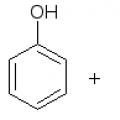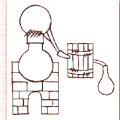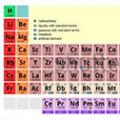DEFINITION
Phenols- derivatives of aromatic hydrocarbons, in the molecules of which the hydroxyl groups are directly bonded to the carbon atoms of the benzene ring. The functional group, like alcohols, is OH.
Phenol is a solid colorless crystalline substance, low melting point, very hygroscopic, with a characteristic odor. In air, phenol oxidizes, so its crystals initially acquire a pinkish tint (Fig. 1), and darken and become more red during long-term storage. It is slightly soluble in water at room temperature, but dissolves quickly and well at 60 - 70 o C. Phenol is fusible, its melting point is 43 o C. Poisonous.
Rice. 1. Phenol. Appearance.
Getting phenol
On an industrial scale, phenol is obtained from coal tar. Among the laboratory methods most often used are the following:
– hydrolysis of chlorobenzene
C 6 H 5 Cl + NaOH→C 6 H 5 OH + NaCl (kat = Cu, t 0).
— alkaline melting of salts of arenesulfonic acids
C 6 H 5 SO 3 Na + 2NaOH → C 6 H 5 OH + Na 2 SO 3 + H 2 O (t 0).
– cumene method (oxidation of isopropylbenzene)
C 6 H 5 -C (CH 3) H-CH 3 + O 2 → C 6 H 5 OH + CH 3 -C (O) -CH 3 (H +, t 0).
Chemical properties of phenol
Chemical transformations of phenol proceed mainly with splitting:
1) O-N connections
- interaction with metals
2C 6 H 5 OH + 2Na→ 2C 6 H 5 ONa + H 2 .
- interaction with alkalis
C 6 H 5 OH + NaOH → C 6 H 5 ONa + H 2 O.
— interaction with anhydrides of carboxylic acids
C 6 H 5 -OH + Cl-C (O) -O-C (O) -CH 3 → C 6 H 5 -O-C (O) -CH 3 + CH 3 COOH (t 0).
- interaction with carboxylic acid halides
C 6 H 5 -OH + Cl-C (O) -CH 3 → C 6 H 5 -O-C (O) -CH 3 + HCl (t 0).
- interaction with FeCl 3 (qualitative reaction to phenol - the appearance of a purple color that disappears when acid is added)
6C 6 H 5 OH + FeCl 3 → (C 6 H 5 OH) 3 + 3Cl -.
2) connections C sp 2 -H predominantly in about- And n-provisions
- bromination
C 6 H 5 -OH + 3Br 2 (aq) →Br 3 -C 6 H 2 -OH ↓ + 3HBr.
- nitration (formation of picric acid)
C 6 H 5 -OH + 3HONO 2 (conc) → (NO 2) 3 -C 6 H 2 -OH + 3H 2 O (H +).
3) a single 6π-electron cloud of the benzene ring
– hydrogenation
C 6 H 5 OH + 3H 2 → C 6 H 11 -OH (kat \u003d Ni, t 0 \u003d 130 - 150, p \u003d 5 - 20 atm).
Application of phenol
Phenol is used in large quantities for the production of dyes, phenol-formaldehyde plastics, and medicinal substances.
Of the diatomic phenols, resorcinol is used in medicine as an antiseptic and a substance for some clinical tests, and hydroquinone and other diatomic phenols are used as developers in the processing of photographic materials.
In medicine, lysol, which includes various phenols, is used to disinfect rooms and furniture.
Some phenols are used as antioxidants - substances that prevent food spoilage during long-term storage (fats, oils, food concentrates).
Examples of problem solving
EXAMPLE 1
| The task | An aqueous solution containing 32.9 g of phenol was treated with an excess of bromine. Calculate the mass of the resulting bromo derivative. |
| Solution | Let us write the reaction equation for the interaction of phenol with bromine: C 6 H 5 OH + 3Br 2 → C 6 H 2 Br 3 OH + 3HBr. As a result of this interaction, 2,4,6-tribromophenol is formed. Calculate the amount of phenol substance (molar mass is 94 g / mol): n (C 6 H 5 OH) \u003d m (C 6 H 5 OH) / M (C 6 H 5 OH); n (C 6 H 5 OH) \u003d 32.9 / 94 \u003d 0.35 mol. According to the reaction equation n(C 6 H 5 OH) :n(C 6 H 2 Br 3 OH) = 1:1, i.e. n (C 6 H 2 Br 3 OH) \u003d n (C 6 H 5 OH) \u003d 0.35 mol. Then the mass of 2,4,6-tribromophenol will be equal to (molar mass -331 g / mol): m (C 6 H 2 Br 3 OH) \u003d 0.35 × 331 \u003d 115.81 g. |
| Answer | The mass of the resulting bromo derivative is 115.81 g. |
EXAMPLE 2
| The task | How to get phenol from iodobenzene? Calculate the mass of phenol that can be obtained from 45.9 g of iodobenzene. |
| Solution | We write the reaction equation for the production of phenol from iodobenzene: C 6 H 5 I + NaOH → C 6 H 5 OH + NaI (kat = Cu, t 0). |
Although phenols are structurally similar to alcohols, they are much stronger acids than alcohols. At the same time, charge delocalization in the phenoxide ion occurs to a lesser extent than in the carboxylate ion; accordingly, phenols are weaker acids compared to carboxylic acids. Phenols are soluble in aqueous sodium hydroxide, but they do not react with sodium bicarbonate. This is the simplest, although not very reliable test by which one can distinguish between phenols and carboxylic acids, which interact with sodium bicarbonate to release carbon dioxide. The effect of a substituent in the benzene ring on the acidity of phenols is consistent with the concept of their electronic effects. Electron-donating substituents decrease, and electron-withdrawing substituents enhance the acidic properties of phenols. Phenols dissociate in aqueous solutions to form phenolate ions and hydrogen ions:
Unlike alcohols, phenols react not only with alkali and alkaline earth metals, but also with alkali solutions, forming phenolates:

With an increase in the length of the hydrocarbon radical, the rate of this reaction slows down. In the presence of traces of moisture, the resulting alcoholates decompose to the parent alcohols.
Tautomerism of phenols
There is a certain analogy between ambident phenoxide and enolate ions. Phenol is also an analogue of enol, and between it and its keto forms (2,4- and 2,5-cyclohexadienes) there should be relations similar to those observed for the equilibrium of the keto and enol forms of ketones.

The ratio of the two tautomeric forms here is completely opposite to that observed for ketones, where the keto form predominates. The stability of tautomeric keto forms increases with the transition to polyatomic phenols. Thus, melting 1,4-dihydroxynaphthalene results in an equilibrium mixture containing 10% diketoforms.

In 1968, V.A. Koptyug and his collaborators proposed a simple and extremely effective way to stabilize the keto form of various phenols using strong Lewis acids - aluminum chloride or bromide. These hard Lewis acids bind the hard carbonyl oxygen of the keto form into a very stable complex that can be fixed. Keto-enol tautomerism underlies the substitution of phenol hydroxyl for an amino group, which occurs when 1- or 2-hydroxynaphthalene, sulfo derivatives of α- and β-naphthols, 6- or 8-hydroxyquinolines and other hydroxy derivatives of naphthalene, anthracene, quinoline are heated with an aqueous solution of sulfite or ammonium hydrosulfite at 130-150 o C.
2.3 Esterification of phenols
Aryl esters of carboxylic acids are obtained by acylation of phenols or their Na-, K-salts with acid halides or anhydrides.

Electrophilic substitution reactions in an aromatic ring
The hydroxyl group is one of the groups that activates electrophilic substitution in the aromatic ring and directs the substituent to the ortho and para positions. The activating effect of the hydroxyl group is so strong that in some cases it is difficult to stop the reaction at the stage of introducing only one substituent. Phenols enter into almost all typical electrophilic substitution reactions with both strong and weak electrophilic agents.
Halogenation of phenols
The halogenation of phenols does not require catalysis by Lewis acids (FeCl 3 , FeBr 3 , AlCl 3 , etc.) and is easily carried out under the action of a molecular halogen. The halogenation of phenol with molecular bromine or chlorine in a polar medium is almost impossible to stop at the stage of monohalogenation, since the reacting particle here is the phenolate ion. The phenolate ion contains a very strong activating group, the oxygen anion, and the rate of halogenation of the phenolate ion is at least a thousand times higher than that of phenol. Halogenated phenol is a stronger acid than phenol, it dissociates more easily, which facilitates the introduction of the second and third halogen atoms in the ortho and para positions.

When phenol is brominated in a solution of hydrobromic acid or when chlorinated in hydrochloric acid, dissociation is completely suppressed and phenol itself undergoes halogenation. In this case, depending on the conditions and the amount of halogen, p-bromophenol or 2,4-dibromophenol can be obtained.


The chlorination of phenol proceeds in a similar way, but here a significant amount of o-chlorophenol is obtained. Monohalogenated derivatives of phenols are conveniently obtained by halogenation in a nonpolar medium, which also excludes the dissociation of phenols.


In all cases, the ratio of para- and ortho-isomers during bromination and iodination is much higher than during chlorination.
According to the number of hydroxyl groups:
monoatomic; for example:
diatomic; for example:

triatomic; for example:

There are phenols and higher atomicity.
The simplest monatomic phenols
C 6 H 5 OH - phenol (hydroxybenzene), the trivial name is carbolic acid.

The simplest dihydric phenols

The electronic structure of the phenol molecule. Mutual influence of atoms in a molecule
The hydroxyl group -OH (like alkyl radicals) is a substituent of the 1st kind, i.e., an electron donor. This is due to the fact that one of the lone electron pairs of the hydroxyl oxygen atom enters into p, π-conjugation with the π-system of the benzene nucleus.

The result of this is:
An increase in the electron density on carbon atoms in the ortho and para positions of the benzene nucleus, which facilitates the replacement of hydrogen atoms in these positions;
An increase in the polarity of the O-H bond, leading to an increase in the acidic properties of phenols compared to alcohols.
Unlike alcohols, phenols partially dissociate in aqueous solutions into ions:

i.e. exhibit weakly acidic properties.
Physical Properties
The simplest phenols under normal conditions are low-melting, colorless crystalline substances with a characteristic odor. Phenols are sparingly soluble in water, but readily soluble in organic solvents. They are toxic substances that cause skin burns.
Chemical properties
I. Reactions involving the hydroxyl group (acidic properties)

(neutralization reaction, unlike alcohols)

Phenol is a very weak acid, therefore phenolates are decomposed not only by strong acids, but even by such a weak acid as carbonic:

II. Reactions involving the hydroxyl group (formation of esters and ethers)
Like alcohols, phenols can form ethers and esters.
Esters are formed by the interaction of phenol with anhydrides or chlorides of carboxylic acids (direct esterification with carboxylic acids is more difficult):

Ethers (alkylaryl) are formed by the interaction of phenolates with alkyl halides:

III. Substitution reactions involving the benzene ring

The formation of a white precipitate of tribromophenol is sometimes regarded as a qualitative reaction to phenol.

IV. Addition reactions (hydrogenation)

V. Qualitative reaction with iron (III) chloride
Monatomic phenols + FeCl 3 (solution) → Blue-violet color, disappearing upon acidification.
The names of phenols are made taking into account the fact that the trivial name "phenol" is preserved for the parent structure according to the rules of IUPAC. The numbering of the carbon atoms of the benzene ring starts from the atom directly bonded to the hydroxyl group (if it is the highest function), and continues in such a sequence that the existing substituents learn the smallest numbers.
Monosubstituted phenol derivatives, such as methylphenol (cresol), can exist in the form of three structural isomers - ortho-, meta- and para-cresols.
physical properties.
Phenols are mostly crystalline (-cresol - liquid) at room temperature. They have a characteristic odor, are rather poorly soluble in water, but dissolve well in aqueous solutions of alkalis (see below). Phenols form strong hydrogen bonds and have fairly high boiling points.
Ways to get.
1. Obtaining from halobenzenes. When chlorobenzene and sodium hydroxide are heated under pressure, sodium phenolate is obtained, upon further treatment of which with acid, phenol is formed:
2. Obtaining from aromatic sulfonic acids (see reaction 3 in the section "Chemical properties of benzene", § 21). The reaction is carried out by fusing sulfonic acids with alkalis. Initially formed phenoxides are treated with strong acids to obtain free phenols. The method is usually used to obtain polyhydric phenols:

Chemical properties.
In phenols, the p-orbital of the oxygen atom forms a single system with the aromatic ring. Due to this interaction, the electron density at the oxygen atom decreases, and in the benzene ring it increases. The polarity of the O-H bond increases, and the hydrogen of the OH group becomes more reactive and is easily replaced by a metal even under the action of alkalis (unlike saturated monohydric alcohols).
In addition, as a result of such mutual influence in the phenol molecule, the reactivity of the benzene ring in the ortho and cara positions in electrophilic substitution reactions (halogenation, nitration, polycondensation, etc.) increases:

1. The acidic properties of phenol are manifested in reactions with alkalis (the old name "carbolic acid" has been preserved):
Phenol, however, is a very weak acid. When carbon dioxide or sulfur dioxide is passed through a solution of phenolates, phenol is released - such a reaction proves that phenol is a weaker acid than carbonic and sulfurous:
The acid properties of phenols are weakened by the introduction of substituents of the first kind into the ring and are enhanced by the introduction of substituents of the second kind.
2. Formation of esters. Unlike alcohols, phenols do not form esters when exposed to carboxylic acids; for this, acid chlorides are used:
3. Halogenation. When bromine water acts on phenol (compare with the conditions for benzene bromination - § 21), a precipitate of 2,4,6-tribromophenol is formed:

This is a qualitative reaction for the detection of phenol.
4. Nitration. Under the action of 20% nitric acid, phenol is easily converted into a mixture of ortho- and para-nitrophenols. If phenol is nitrated with concentrated nitric acid, then 2,4,6-trinitrophenol is formed - a strong acid (picric).
5. Oxidation. Phenols are easily oxidized even under the action of atmospheric oxygen.
So, when standing in air, phenol gradually turns into a pinkish-red color. In the vigorous oxidation of phenol with a chromium mixture, quinone is the main oxidation product. Dihydric phenols are oxidized even more easily. When hydroquinone is oxidized, quinone is formed:

The chemical properties of phenols are determined by the presence of a hydroxyl group and a benzene ring in the molecule.
Reactions at the hydroxyl group
Phenols, like aliphatic alcohols, have acidic properties, i.e. able to form salts phenolates. However, they are stronger acids and therefore can interact not only with alkali metals (sodium, lithium, potassium), but also with alkalis and carbonates:
Acidity constant RK but phenol is 10. The high acidity of phenol is associated with the acceptor property of the benzene ring ( pairing effect) and is explained by the resonance stabilization of the resulting phenolate anion. The negative charge on the oxygen atom of the phenolate anion can be redistributed over the aromatic ring due to the conjugation effect; this process can be described by a set of resonance structures:

None of these structures in isolation describes the real state of the molecule, but their use makes it possible to explain many reactions.
Phenolates readily react with haloalkanes and acid halides:

The interaction of phenol salts with haloalkanes is the reaction of O-alkylation of phenols. This is a method for obtaining ethers (Williamson reaction, 1852).
Phenol is able to interact with acid halides and anhydrides to give esters (O-acylation):

The reaction proceeds in the presence of small amounts of mineral acid or by heating.
Reactions on the benzene ring
Hydroxyl is an electron donating group and activates ortho- And pair- positions in electrophilic substitution reactions:

Halogenation
Halogenation of phenols by the action of halogens or halogenating agents proceeds at a high rate:


Nitration
When nitric acid in acetic acid (in the presence of a small amount of sulfuric acid) acts on phenol, 2-nitrophenol is obtained:

Under the action of concentrated nitric acid or a nitrating mixture, phenol is intensively oxidized, which leads to a deep destruction of its molecule. When dilute nitric acid is used, nitration is accompanied by strong gumming despite cooling to 0°C and leads to the formation about- And P- isomers with a predominance of the first of them:

When phenol is nitrated with dinitrogen tetroxide in an inert solvent (benzene, dichloroethane), 2,4-dinitrophenol is formed:

Nitration of the latter with a nitrating mixture proceeds easily and can serve as a method for the synthesis of picric acid:

This reaction proceeds with self-heating.
Picric acid is also obtained via a sulfonation step. To do this, phenol is treated at 100 ° C with an excess amount of sulfuric acid, a 2,4-disulfo derivative is obtained, which, without being isolated from the reaction mixture, is treated with fuming nitric acid:

The introduction of two sulfo groups (as well as nitro groups) into the benzene core makes it resistant to the oxidizing action of fuming nitric acid, the reaction is not accompanied by resinification. This method of obtaining picric acid is convenient for production on an industrial scale.
Sulfonation . The sulfonation of phenol, depending on the temperature, proceeds in ortho- or pair-position:

Alkylation and acylation according to Friedel-Crafts . Phenols form inactive ArOAlCl 2 salts with aluminum chloride, therefore, for the alkylation of phenols, protic acids (H 2 SO 4) or acid-type metal oxide catalysts (Al 2 O 3) are used as catalysts. This allows only alcohols and alkenes to be used as alkylating agents:

Alkylation proceeds sequentially with the formation of mono-, di- and trialkylphenols. Simultaneously, an acid-catalyzed rearrangement occurs with the migration of alkyl groups:

Condensation with aldehydes and ketones . Under the action of alkaline or acid catalysts on a mixture of phenol and fatty aldehyde, condensation occurs in about- And P-provisions. This reaction is of great practical importance, since it underlies the production of important plastics and varnish bases. At ordinary temperature, the growth of a molecule due to condensation proceeds in a linear direction:



If the reaction is carried out under heating, condensation begins with the formation of branched molecules:

As a result of accession for all available about- And P-positions, a three-dimensional thermosetting polymer is formed - bakelite. Bakelite is characterized by high electrical resistance and heat resistance. It is one of the first industrial polymers.
The reaction of phenol with acetone in the presence of a mineral acid leads to the production of bisphenol:

The latter is used to obtain epoxy compounds.
Kolbe-Schmidt reaction. Synthesis of phenylcarboxylic acids.
Sodium and potassium phenolates react with carbon dioxide, forming, depending on temperature, ortho- or para-isomers of phenylcarboxylic acids:

Oxidation
Phenol is easily oxidized by the action of chromic acid to P-benzoquinone:

Recovery
The reduction of phenol to cyclohexanone is used to produce polyamide (nylon-6,6)





